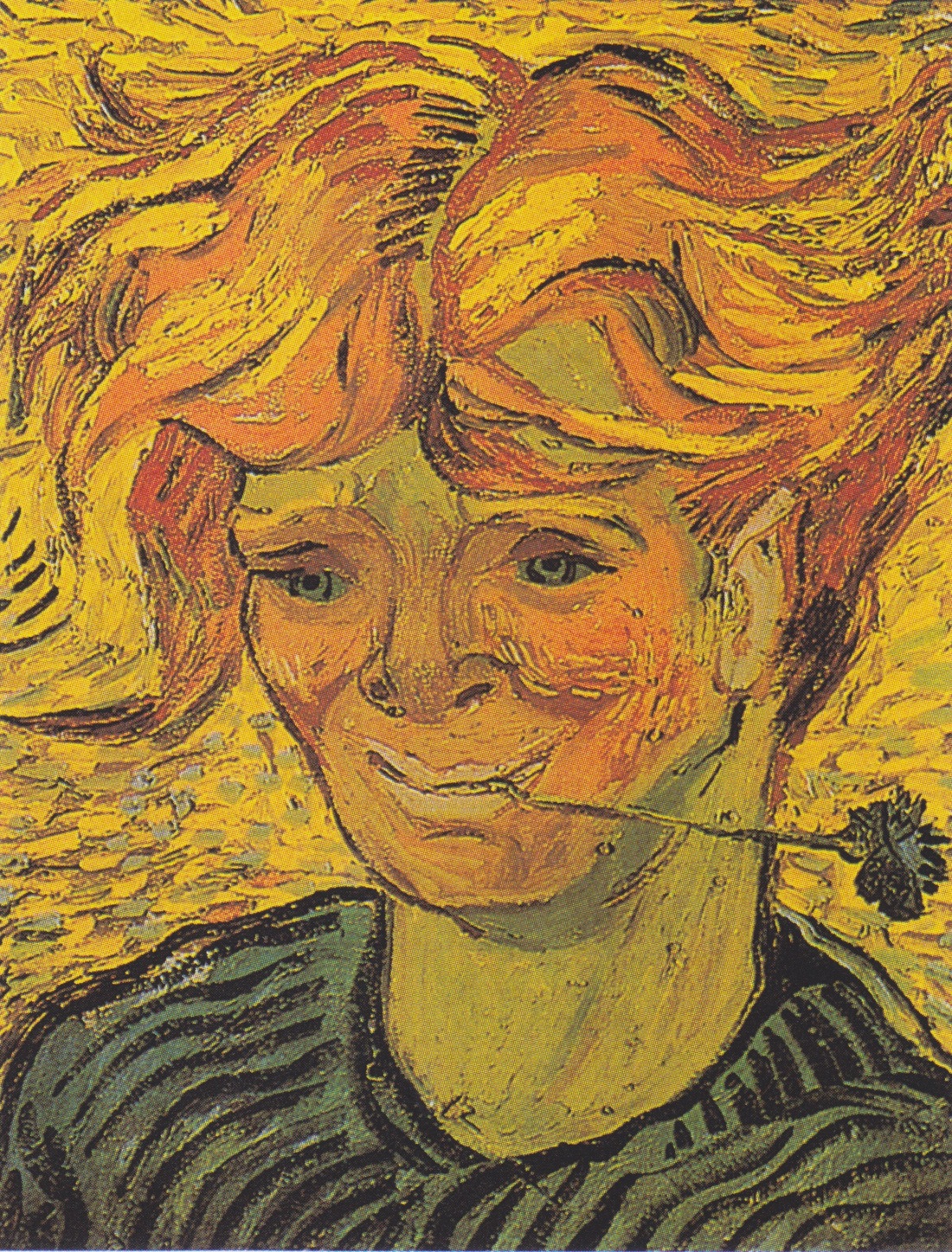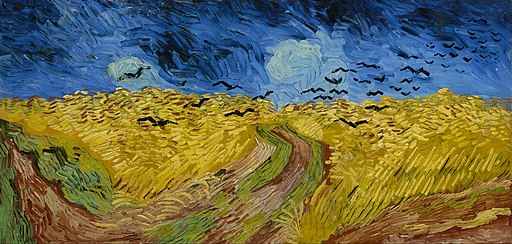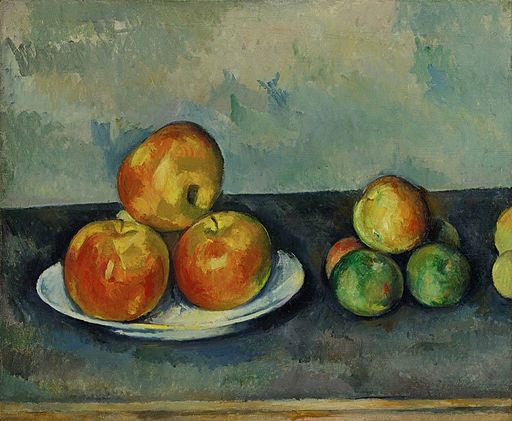1890
See also : France Monet Vétheuil to Giverny Cézanne Renoir Van Gogh Landscape Flowers Tabletop Bouquet Children
1890 MONET
1
Summer 1890 Champ d'Avoine et de Coquelicots
2022 SOLD for $ 14M by Christie's
During Spring, he makes two series of respectively two and four paintings on the blooming meadows with poplars in the background.
Two Summer series of five each illustrate oat fields covered with poppies. He shifts in October to the theme of the haystacks.
Champ d'avoine et de coquelicots, oil on canvas 65 x 92 cm, is a view in a warm summer day just before the harvest. An effect of distance is provided by a differentiated palette for two banks of trees, the farther being wrapped in a haze of heat.
It was used as a complement to the Meules with three other poppy fields in the 1891 groundbreaking Meules exhibition at Galerie Durand-Ruel. It had two owners from new, Durand-Ruel and a family that treasured it since 1914.
It was sold for $ 14M by Christie's on May 12, 2022, lot 25C.
2
Autumn 1890 Meules
2019 SOLD for $ 110M by Sotheby's
He had been very active throughout that period. His paintings of the Gare St Lazare in 1877 constituted a series that displayed the variations in color depending on the intensity of sunlight and on the thickness of smoke from the trains. His solitary travel in Normandy in 1882 for comforting after the death of Camille is very important : Monet demonstrates to himself that lighting is better than topography for expressing a mood.
Every year the grain stacks will remain alone in the middle of the fields as temporary semaphores that break until the wheat threshing of the spring the monotonous ground devoid of its plants by winter. They will be the suitable support for Monet to perform his observations of colors through all weather conditions and at all moments of time.
Monet loves this theme that is typical of country life without the need to add humans or birds. He begins at the end of summer 1890 with five landscapes in which two haystacks are distant from each other.
According to the sequence established by Wildenstein, the next sub-series is composed of two oil paintings on canvas 73 x 93 cm executed during the autumn of 1890. The alignment of two haystacks leads to the tall trees on the horizon, against the light in the last rays of sunset. For the first time the rest of the image is minimized. The predominance of the expression of colors over theme and form opens the way to modern art.
The second of these pictures, W1273, goes even further by managing to avoid the shadows of the two stacks. All that remains is the light that plays with the contours of stacks and trees and reveals the shimmering colors of the field. It was dated 1891 by the artist, certainly by reference to the year of the first public exhibition of the series, in the gallery of Durand-Ruel.
W1273 was sold for $ 110M from a lower estimate of $ 55M by Sotheby's on May 14, 2019, lot 8. Please watch the video shared by the auction house.
An enduring symbol of Impressionism from Claude Monet's iconic Haystacks series will lead an important private collection of 8 Impressionist works on offer in #SothebysImpMod Evening Sale on 14 May in #NYC. Learn more: https://t.co/B4xVl8QWFA pic.twitter.com/SMDorfOowE
— Sotheby's (@Sothebys) March 15, 2019
1890 Van GOGH
1
masterpiece
May 1890 L'Eglise d'Auvers
Musée d'Orsay
2
June 1890 Portrait du Dr Gachet
1990 SOLD for $ 82.5M by Christie's
Gachet, 62, is a doctor, a psychiatrist and a friend of the artists. The subject of his doctoral thesis had been a study on melancholy. He advised several members of the Impressionist group on their health problems and had attempted to assist the engraver Charles Méryon in the final phase of his internment.
Vincent is surprised by their first meeting, during which he considers that Gachet is crazier than him. However, the doctor is skillful : in two days he gains the confidence of this hypersensitive artist.
For his art, Vincent seeks to express the deepest psychological aspects. He is still and always passionate about the examples of his predecessors, to better overcome them. He admires the expression of madness in the imaginary portrait by Delacroix of the poet Torquato Tasso in the madhouse of Ferrara.
The Portrait of Dr Gachet is an oil on canvas 67 x 56 cm painted in June 1890. Vincent commented on this work in a letter to his sister. He wanted to display the melancholy of his new friend while recognizing that his expression can be considered a grimace. He sums up his qualities in four words : Sad but gentle and yet clear and intelligent.
Gachet has his head resting on his right hand, allowing a diagonal composition of great expressive force. The face is drawn with the hard lines of the best works of Vincent. On the table, two bright yellow books balance the composition. A branch of digitalis, a medicinal herb, symbolizes Gachet's main activity.
The Portrait of Dr Gachet was sold for $ 82.5M by Christie's on May 15, 1990. The image is shared by Wikimedia.
3
June 1890 for Dr Gachet
2014 SOLD for $ 62M by Sotheby's
In May 1890 Vincent moved into a room at the local inn in Auvers. He did not have a studio and regularly attended the home of Gachet, a friend of the Impressionists and Cézanne.
Since he is sick, Vincent is terrorized by the idea of failure and by the risk of a new crisis of dementia. With the energy of despair, he gives a new impetus to his old ambition to become the best painter of all time, the only one capable of a synthesis of all genres. Gachet has a painting by Cézanne showing a bouquet of flowers. Vincent wants to do better.
Spring brings forth the flowers into the fields. On November 4, 2014, Sotheby's sold for $ 62M from a lower estimate of $ 30M an oil on canvas 66 x 50 cm painted by Vincent on 16 and 17 June 1890, lot 17. Executed in the clear intention to thank Gachet for his help, this artwork shows a vase filled with daisies and poppies.
The composition is powerful and the colors are gorgeous, dominated in the center by the fiery red poppies. The groups of flowers shine like some characters within the ultimate tragedy of Vincent.
Please watch the video shared by Sotheby's :
4
June 1890 Jeune Homme au Bleuet
2021 SOLD for $ 47M by Christie's
Le Jeune homme au bleuet is an unidentified young peasant boy of whom Vincent painted the portrait in June 1890 in Auvers.
The portrait is uncompromising. The lower class boy has a sun bathed dark skin, a shaggy blond hair, a sad gaze and a forced smile. He holds a cornflower between his lips. The line is much expressive in the style of Vincent's later works.
This oil on canvas 40 x 32 cm was sold for $ 47M from a lower estimate of $ 5M by Christie's on November 11, 2021, lot 21C.
5
Bouquet after Cézanne
2020 SOLD for $ 16M by Sotheby's
Vincent is euphoric, until the return of his psychiatric disorders at the end of July. His creativity is at its peak. Benefiting from all his research in Arles and Saint-Rémy, he fulfils his mad dream of being the best painter in the world. He knows that he will never be able to stop time, and paints an average of one canvas per day. He works too fast and can no longer describe all his creativity in his letters to Theo.
Gachet owned two paintings of bouquets made by Cézanne in 1873. One of the bouquets is placed on a round table in a slightly plunging view, an early example of Cézanne's passion for reinterpreting perspectives. A backdrop adjoins the contours of the table.
Vincent painted an oil on canvas inspired by this bouquet at an undetermined date. He replaces the Delft vase with a transparent and shiny glass. The flowers take on the vivid colors from his experiences with Gauguin at the Maison Jaune. The concave background, which occupies the entire width of the image, is iridescent like a reflection of the blue sky and possibly the bouquet.
This oil on canvas 41 x 33 cm was sold for $ 16M by Sotheby's on October 28, 2020, lot 127. Please watch the video shared by the auction house.
#AuctionUpdate: One of Vincent van Gogh’s finest flower paintings, ‘Fleurs dans un verre’ from 1890 sells for $16 million. Executed at the height of his artistic powers, the work is one of the final canvases that Van Gogh painted just days before his untimely death in July 1890. pic.twitter.com/BIBPX0Da7n
— Sotheby's (@Sothebys) October 29, 2020
6
masterpiece
July 1890 Champ de Blé aux Corbeaux
Van Gogh Museum, Amsterdam
breakthrough
1890 The Night by Hodler
Kunstmuseum Bern
In 1890, The Night is a group of recumbent nudes visited by an allegory of death. It is considered obscene in Geneva in 1891 before being lauded at the Paris Salon by Puvis de Chavannes and Rodin. The image is shared by Wikimedia.
CEZANNE
1
1888-1890 Madame Cézanne au Fauteuil Jaune
1997 SOLD for $ 23M by Christie's
In real life Cézanne focused on his art, with a much limited interest in other people including his partner. When they finally married in 1886, Paul had no longer any feeling for her. His excuse was : "Ma femme n'aime que la Suisse et la limonade". She was for him an available model whom he installed still in an armchair just like he positioned his jars, fruit and tablecloth on his table.
The seminal opus in that series is Madame Cézanne au fauteuil rouge, painted in 1877. She looks bored, not trying to communicate. The arms folded on the lap certainly inspired the portraits in high backed armchairs by Modigliani and Picasso.
Madame Cézanne au fauteuil jaune, oil on canvas 80 x 64 cm, was sold for $ 23M by Christie's on May 12, 1997, lot 115.
By comparison with three similar paintings, it had been made in the apartment which the artist rented in Paris for his family from 1888 to 1890. They must be considered as color studies. The primary colors of dress, chair and wall contrast with the much elaborated color of the face.
2
1889-1890 Pommes
2013 SOLD for $ 42M by Sotheby's
Cézanne plays with apples like an infant with cubes. Fruits are grouped within small uneven piles in which their variety of colors brings an additional appeal. Sometimes a group is interrupted by the frame as if the row of fruit was unlimited.
If we consider that the real subject is the painting itself and not the appealing fruit, Cézanne's apples anticipate abstract art. His still life puzzles the viewer by its original composition, as if it tried to tell a story or to evoke a feeling, like Kandinsky and Miro later. Each individual element is however realistic like an image by Chardin.
The group of apples for sale at Sotheby's on May 7, 2013 is both simple and bold. This oil on canvas 38 x 46 cm painted in 1889-1890 was sold for $ 42M from a lower estimate of $ 25M, lot 7. Please watch the video shared by the auction house. The image is shared by Wikimedia.
Sold for $ 60M at Sotheby's on May 10, 1999, another composition, 60 x 73 cm, painted four years later is more ambitious. The folds of the white tablecloth generate a complex interplay of fruit, the pitcher is the referee and the curtain states that the still lifes of Cézanne are indeed dramas.
3
1888-1890 Pommes et Poires
2021 SOLD for $ 20M by Sotheby's
This oil on canvas 38 x 46 cm is by its composition a twin painting of Les Pommes, a still life of same format and period sold for $ 42M by Sotheby's on May 7, 2013, also with a lower estimate of $ 25M.
Both arrangements are made on the top of the same chest, the same or very similar as the furniture shown in Cézanne's still life in Paris more than ten years earlier. The replacement by pears of a group of apples may result from a desire to vary the colors.
The major difference is that Pommes et Poires occupy a delimited space while in Les Pommes two apples on the right edge call for an unlimited raw of fruit, anticipating the color escapes of Mondrian.
No timeline can be defined within the middle format series of still lifes of the later 1880s. In this time of prevailing experimentation, it is indeed probable that Les Pommes and Pommes et Poires were painted in parallel.
#AuctionUpdate: A rare example of Paul Cézanne’s quintessential still lifes of this caliber remaining in private hands, 'Nature morte: pommes et poires' achieves $20 million. The work last sold at auction at Sotheby’s NY for $8.7 million in November 2003. pic.twitter.com/S5lGB94w7Z
— Sotheby's (@Sothebys) May 13, 2021
1890 Jeune Fille à la Corbeille de Fleurs by Renoir
2021 SOLD for $ 13M by Sotheby's
Jeune Fille à la Corbeille de Fleurs, oil on canvas 81 x 65 cm, is a masterpiece of that new period and the most expensive work that Durand-Ruel acquired from Renoir in the full year 1890. Two oil studies in the same format for that finished painting were also bought by Durand-Ruel.
The well dressed girl with a growing breast is slightly bending her head for engaging her charming gaze and smile with the viewer. The pose is inspired from Ingres's Portrait de Madame Rivière.
This exquisite portrait was sold for $ 13M from a lower estimate of $ 6M by Sotheby's on November 16, 2021, lot 33. Please watch the video shared by the auction house. The catalogue reports that the second study had been sold for $ 8.5M in June 1993.







